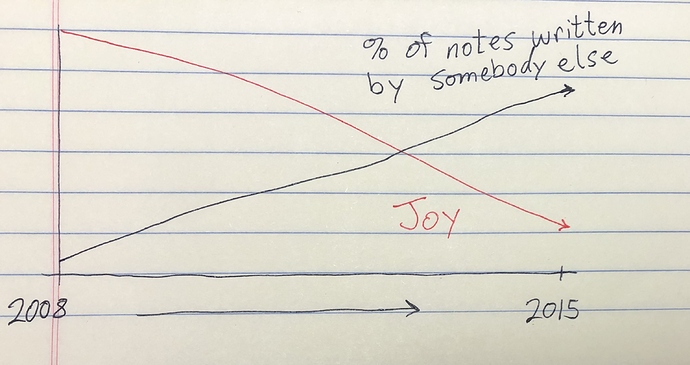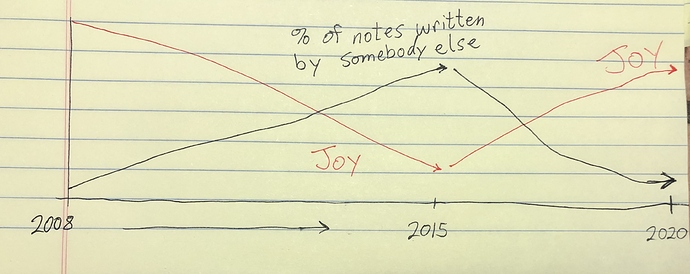Hey everyone!
Some of you know me for creating the IMF Kit, but I wanted to share the story behind it—plus I have some news ![]()
Fast notes
I started with Evernote in 2008. Before that was Microsoft Word, so Evernote offered a major difference. It was great. It allowed for FAST NOTES. Finally, I could create notes as quickly as I could think of them. I could also “clip” web articles effortlessly. That’s a good thing, right? Well, it was…for the first few years.
I used Evernote to grow, develop, and manage a fitness boxing business—expanding it in the US, Scandinavia, and Saudi Arabia. I also used it extensively to help act in and produce two indie feature films, along with a bunch of other typical uses like writing, tracking, and journaling.
But as my digital note library grew, I had more difficulty finding notes. That’s when I developed a basic system of using “Maps", which were just “notes with links to other notes.” (I didn’t call them MOCs then, but that’s basically what they were.) It was clunky, but I made these Map Notes for my boxing business, for producing the indie films, and a myriad of other things.
It worked, but secretly, the health of my digital note system was failing. A hidden cancer was growing—and I was feeling it more everyday.
The problem was that my library was becoming less of my library. As I clipped more articles, the ratio of my own words and thoughts decreased. This made it harder to search for my thoughts. While those articles felt important at the time, they almost always led to nothing.
Yes, we shape our tools, but in turn, our tools shape us.
Little did I know that my habit of saving articles was—over time—increasing the NOISE and decreasing the SIGNAL. I.e. my digital library was filling up with garbage.
After 5 years, opening Evernote was no longer fun. It was stressful. It caused my mind to feel scattered. Just the thought of opening it created surprising amounts of anxiety.
The happiness I used to feel using my digital note library was experiencing “death by a thousand cuts.” And when you have tons of valuable thoughts locked away in an environment you don’t want to enter—you start feeling the effects of “digital dementia.”
My joy evaporated.
I decided to leave Evernote. And that’s when I fully understood that my notes were trapped. My valuable ideas, my personal thoughts…they were trapped in a proprietary format that Evernote used (and possibly sold to third parties). It was like the line from Hotel California, “You can check out any time you like, but you can never leave.”
Eventually, I figured out a way to export to plain text, and it BROKE. EVERY. LINK. My Map Notes were unusable. The formatting was horrid. I’m still uncovering old notes that break my flow because they need to be reformatted.
If you haven’t experienced the pain of transferring your notes out of a proprietary format, please learn from people like me who have. Even years later, Evernote still manages to punch me in the gut when I open an old note that hasn’t been reformatted. It can sabotage your work sessions years into the future.
Free notes
By the end of 2015, my notes were now plain-text files. I could still make FAST NOTES, but now they were also FREE NOTES. Plain-text files offer you full ownership of your notes and freedom from the bad actors selling your personal information. But they are plain.
So using markdown added a layer on top of the plain-text to allow enough formatting to make the experience much more usable. I used apps like Notational Velocity and nvALT before using The Archive (made by the folks at zettelkasten.de).
Linked notes
Now FAST NOTES and FREE NOTES were able to become LINKED NOTES! Since these apps allowed for linking (technically by searching), I was able to develop my Map Notes to the next level.
Thinking through linking ideas is seriously a revolution. Sure, the internet has had links for decades, but now regular peons like you and me can create links as quickly as we can think of them—without any programming needed! This changed the equation in my knowledge management efforts. My joy for note-making started coming back.
Using the Maps
A few years ago, I wanted to share my Map Notes with the zettelkasten community. But I doubted my ideas. The Zettelkasten Method is largely a revolt against “structure” and yet I was finding a way to add it back? Surely I was falling back into the trap of too much structure, right? Ultimately, I decided not to share my system of Maps with the community.
But I couldn’t ignore how well my Map Notes were working for me. I used them as the foundation for my entrance into the entertainment industry in Los Angeles. In the span of one year, I went from being a PA (essentially getting people coffee), to being the assistant editor on a feature film (working for a brilliant Emmy winning editor), to getting my first credit as an editor (a 5x upgrade in pay).
While being in the right place at the right time certainly played a role, so did having a system of digital notes that I could develop and trust. I used it to accelerate my career by extensively developing 4 major MOCs under the topics of: The Industry, Relationships, Storytelling, and the Craft of Editing.
I felt I had a few special ideas—like MOCs—that I hadn’t seen elsewhere else. But I also figured it was just a cognitive bias I had. So when the Obsidian beta came around, I thought “Here’s a community that will tell me how crazy my ideas really are!"
And that’s when the IMF Kit was born (soon to be the LYT Kit).
It solves the two biggest problems in PKM: too much structure and too little.
Too much structure
The biggest problem with Microsoft Word and even Evernote was how dependent they are on folders (not to mention crippling “feature-bloat”). Our brains don’t work naturally within a folder-dominant framework. It makes it difficult to develop ideas.
Too little structure
The “Folder Rebellion” has now gone mainstream with apps like The Archive, Roam, and Obsidian. They all rely on LINKS as the main way of relating notes. Links are an evolutionary leap over folders. Links encourage the development of your ideas to more closely resemble how our brains actually work.
But the problem with only using links is how claustrophobic it can feel…Like you’re navigating Mirkwood Forest at night with only a torch. Sure it’s adventurous, but sometimes you want the birds-eye view.
The LYT Kit (aka IMF kit) solves both of these problems: you can develop ideas quickly and effortlessly using Direct Links; and you can zoom out and confidently see the bigger picture at any time!
I was surprised by the BIG response to the original IMF Kit. It inspired me to make it better and more accessible. I was filled with joy to hear how it helped others have more fun and confidence in building their PKM systems.
[[Linking Your Thinking]] The Workshop
Since the last kit came out, I’ve been investing a lot of time in developing a new version of it because I don’t want you to experience unnecessary pain with your notes as I did—instead, I want you to experience ongoing joy with them.
During the last two months, I tested out my ideas with a private online focus group. I created a 6-week workshop for some members of the Obsidian community who were serious about improving their PKM skills.
Based on their feedback… I’m not crazy (phew)! There’s real value here that can help you feel more joy and confidence with your digital notes system—not just in the short-term, but in the decades to come.
Upcoming Workshop, Limited Spots
My dream is to help over 1000 people take their thinking to another level—while future-proofing their notes for decades to come and having more joy in the process.
To make this dream a reality:
I’m launching the first public Linking Your Thinking online workshop. It will start October 27th and go for 6 weeks. It’s limited to 12 spots.
At the end of the online workshop, you’ll walk away with:
- increased confidence in your PKM system and increased joy using it
- new tools to reliably think at a higher and sustained level
- your own personalized, antifragile, flexible, future-proof PKM system
- a group of “modern” friends that you can learn from and feel comfortable sharing ideas with
If you’re at all interested in learning more, join HERE to be the first to hear the details that will be dropping over the next several weeks—including the webinar for how to use the LYT Kit.
New Youtube Channel
Also, as of today, I’ve launched a new Youtube channel to share these ideas. I’m starting with a series on How to Get Started with Obsidian if you’re a Complete Beginner
If you are new to Obsidian or have friends that you think would love Linking their Thinking, please watch and share the link.
Thanks to a Most Amazing Community
This pandemic has been a rollercoaster…I’m grateful for connecting with so many awesome and excellent thinkers. I’ve learned a tremendous amount from many of you and have had a blast in the process. It’s truly amazing how much faster we learn when we learn together.
If you have questions about the upcoming workshop or just about how to do certain things, please reach out or comment below.
Stay connected!
Nick




